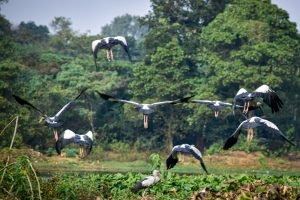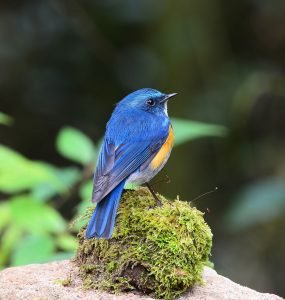BY DEBAJYOTI CHAKRABORTY
ASANSOL, 9 DECEMBER 2022
“ Migration is an integral part of the aviation life cycle which is going on since the past thousand years,” according to Martin Wikelski, Director of Max Planck Institute for Ornithology, Germany.

Its winter and the epic journey has already begun and bird lovers are eager to welcome their feathered guests as the greatest spectacle of annual escape on the skies in earth unfolds in a covid free world after a hiatus of almost two years.

With four new migratory bird species, Small niltava, rusty tailed flycatcher, himalayan bluetail, rosy pipit found last year for the first time in the water bodies, the nature lovers of Asansol are excited that this year more surprises are in the waiting.

Already the winter migratory birds have arrived in large numbers in the vast waterbodies in Asansol, but still two birds Tufted duck and Gadwill have not been spotted by bird watchers and forest officials so far.

According to last year’s census there were 1000 ducks in Asansol, 200 gulls, 200 raptors, 6000 waders and over 10,000 small birds.

Talking to THE TRAVEL AND TOURISM TIMES, Saptarshi Mukherjee, Wild Tuskers, a nature lover organisation working along with the forest department on the conservation of migratory and other bird population of the district said that this year the census will be conducted on numbers of ducks and waterfowl in Asansol.

Basically four types of migratory birds are found in Asansol – summer, monsoon, winter, and local. This year the numbers of summer migrants were huge, basically the three most gorgeous species – Indian Pitta, Asian Paradise Flycatcher and black naped monarch were found. Another summer migrant found this year was a banded bay cuckoo. In Monsoon migrants the numbers of jacobin cuckoos were abundant and the number of indian cuckoos are also found significantly increasing.

Last winter, the winter migrants were abundant. About 40 species of Ruddy Shelduck ( migrants of Tibet) were spotted. The numbers of wagtails, taiga flycatcher, sandpipers, little ringed plovers, and gulls were satisfactory.

“ We also found gadwill and red crested pochards ( duck species) as well. This year, there has been a slight decline in ducks. However the migration is still going on. Ruddy Shelducks have arrived but in fewer numbers. The reason is probably the sharp decline in habitat and encroachments,”he said.

Seven years ago, the shelducks resided just behind in Nehru Park. But now they have shifted towards the Bhootnath Baba Temple, near the railway bridge. The incidents of poachings have come down considerably due to awareness campaigns and regular vigils.

However, this year already two raptors have been spotted and also peregrine falcon, eurasian hobby, both are migratory. Wild Tuskers, a bunch of volunteers and nature lovers of Asansol are trying to educate the local schools about the importance of birds as well as biodiversity and conservation of the ecosystem.

In Asansol, the main migration area is Damodar River. Apart from that, Gunjan Ecological Park, Colonel Singh Park, Boat Club in Chittaranjan attracts a large number of migratory birds.

However, there is a sharp decline in Gunjan Park, because of winter picnic parties and habitat destruction.

The authority of Chittaranjan Locomotive Works (CLW) has taken expert guidance from Dhanbad based bird expert, Akhilesh Kumar Sahai for further improvements around the habitats in the lakes of the railway towns. Usage of polythene bags has been banned in the railway town. Satish Kumar Kashyap, the GM of CLW is also a bird and nature lover.

There are nearly 160 types of wetland birds in west Bengal. From the Paleo-Arctic region, North Asia, Europe, Siberia and other cooler places between late October and early April the winter migratory birds come to roost at the huge water bodies spread over the industrial towns of Burnpur, Asansol and Chittaranjan in West Bengal.
India has also signed non legally binding MOU with Conservation of Migratory Species (CMS) few years ago on the conservation and management of Siberian Cranes (1998), Marine Turtles (2007), Dugongs (2008) and Raptors (2016).

India is temporary home to several migratory animals and birds. The important among these include Amur Falcons, Bar headed Geese, Black necked cranes, Marine turtles, Dugongs, Humpbacked Whales, etc. The Indian sub-continent is also part of the major bird flyway network, i.e, the Central Asian Flyway (CAF) that covers areas between the Arctic and Indian Oceans, and covers at least 279 populations of 182
migratory water bird species, including 29 globally threatened species. India has also launched the National Action Plan for conservation of migratory species under the Central Asian Flyway.

Change of crop pattern, use of pesticides and loss of habitat have led to loss of as much as 80 percent of the migratory bird arrivals to the wetlands of the country.
Scarcity of food and extreme cold are the reasons behind the annual ‘Great Escape” of the millions and millions of migratory birds fromthe chilly northern winter since the past thousand years.

Advertisement:






























Add Comment